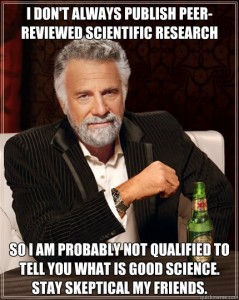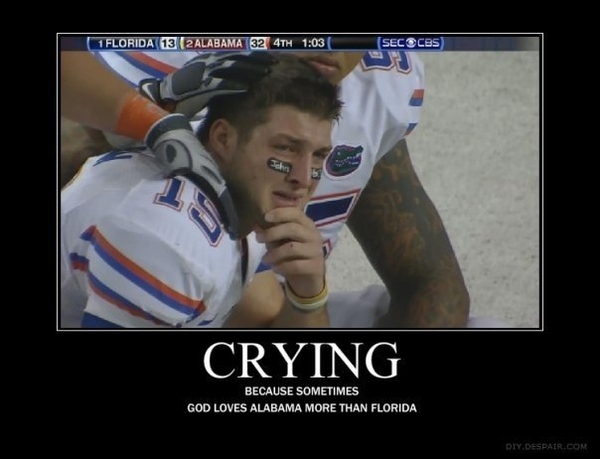
The Discovery Institute posted a long and painful defense of Intelligent Design as a “scientific idea” today [1]. It was painful because it seemed based on a pre-college level of understanding of the scientific method. Their primary defense was founded on shoe-horning intelligent design into a scientific method-looking structure, but evidence of their misunderstanding and misrepresentation of science is evident right in their application of the steps of the method.
The gross stages of the scientific method are: to make an observation of a phenomenon in the natural world; construct a hypothesis – a testable idea – to explain the observation; conduct a test of the predictions of the hypothesis; and then draw conclusion about the test (was the hypothesis disproven? If not, conduct another test of its predictive powers).
Casey Luskin writes the post, and here is one example of his shoe-horning bad science into something that sounds sciency:
Observation: Intelligent agents solve complex problems by acting with an end goal in mind, producing high levels of [complex specified information (CSI)]. In our experience, systems with large amounts of specified complexity — such as codes and languages — invariably originate from an intelligent source. Likewise, in our experience, intelligence is the only known cause of irreducibly complex machines.
Hypothesis (Prediction): Natural structures will be found that contain many parts arranged in intricate patterns (including irreducible complexity) that perform a specific function — indicating high levels of CSI.
Experiment: Experimental investigations of DNA indicate that it is full of a CSI-rich, language-based code. Biologists have performed mutational sensitivity tests on proteins and determined that their amino acid sequences are highly specified.22 Additionally, genetic knockout experiments and other studies have shown that some molecular machines, like the flagellum, are irreducibly complex.23
Conclusion: The high levels of CSI — including irreducible complexity — in biochemical systems are best explained by the action of an intelligent agent.
There are so many glaring errors in this – some so big, you might miss them at first – that it’s painful. PAINFUL. Here are some obvious ones.
- Complex specific information (CSI) is a concept that was articulated by William Dembski in some of the few published and peer-reviewed papers produced by any proponent of Intelligent Design. It’s been roundly refuted by mathematicians and philosophers [2], its foundations shown to be mathematically inconsistent and incorrect, and its assumptions weak and poor. Not only that, Demsbki’s filter for detecting design has been shown to find design in pure randomness. Oops. An unreliable method is a terrible foundation for a solid hypothesis, as any beginning student of the scientific method can tell you. This is akin to forming a hypothesis based on the assertion that the “earth is flat.”
- The hypothesis naively and narrowly assumes that the form of intelligence we know about – human intelligence – is the only kind of intelligence that can produce information in a system; or, more to the point, that when we see complexity that could have resulted from human intelligence, we are to assume that some intelligence caused it. It’s unscientific hubris of the worst kind to assert that complexity, based on engineering choices humans might make, represents the only kind of intelligence. There is no generic definition of intelligence (certainly not from complex specified information, which is discredited). Since there is no evidence-based foundation for this assertion, this assertion is weak, and thus forms another weak basis for the hypothesis.
- They invoke “experience” to justify assertions. Wrong. Evidence and data is what you use to justify the a proposed explanation of some observation. “Experience” suggests a personal set of small-statistics, biased by your set of expectations; data and evidence, however, are collected via a rigorous protocol and subjected to quality assessment. “Experience” is no substitute for evidence.
The worst error here is the most obvious, and hardest to see. Let me simplify Luskin’s example, removing all the fluff to boil down his example to its core.
Observation: Intelligent agents result in complexity.
Hypothesis (Prediction): I will observe complexity in nature, and that can only be explained by intelligence.
Experiment: Other people have noticed that there are some hard-to-explain (“complex”) structures in nature.
Conclusion: Complexity is best explained by the action of an intelligent agent.
See it? Luskin’s example is a tautology – assuming the premise to draw the conclusion. The truth of the premise cannot be refuted, by construction. Nowhere in here does he begin with or even ADMIT the most established explanation of complexity in nature – Natural Selection. Instead, he weaves a logical loop that never ends – a Moebius of Misunderstanding.
This is not science. This is bullshit.
A proper hypothesis-test-conclusion would be the following:
- I observe X – something that seems complex to me – whose explanation is not immediately obvious to me.
- I hypothesize that there is a path by which this structure arose in nature, and apply the known physical laws to attempt to explain it.
- I construct an experiment to determine if X could have arisen naturally, from forces in the natural world (chemistry, physics, biology). This experiment could, for instance, be to try to recreate the structure in the lab through Natural Selection forces or, more simply, to look in the natural world for related structures that might have evolved into X through the application of Natural Selection.
- Either the hypothesis passes the test or not. I publish in a peer-reviewed journal either way, subjecting my method and results to a bloodbath of criticism. If successful, it gets published and the idea enters the public domain, to be confirmed or refuted by independent experimentation.
At no point do I conclude: “Too hard – must have been designed by some intelligence.” That’s called “giving up.”
Intelligent Design Creationists try to represent themselves as something other than a straw man, and in doing so demonstrated that they are both a straw man of themselves and, worse, they are begging the question.
Don’t even get me started about the irony of them whining about being treated like a straw man, when they haven’t demonstrated that they understand the basic principles of the Theory of Natural Selection during the entire time they’ve been seeking to recast it as a straw man and then knock it down.
[1] http://www.evolutionnews.org/2013/08/what_is_the_the075281.html
[2] For examples of refutations of Dembski’s discredited ideas, with references, see http://www.talkorigins.org/indexcc/CI/CI110.html


